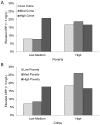Elevated C-reactive protein in children from risky neighborhoods: evidence for a stress pathway linking neighborhoods and inflammation in children
- PMID: 23049799
- PMCID: PMC3458094
- DOI: 10.1371/journal.pone.0045419
Elevated C-reactive protein in children from risky neighborhoods: evidence for a stress pathway linking neighborhoods and inflammation in children
Abstract
Background: Childhood socioeconomic status is linked to adult cardiovascular disease and disease risk. One proposed pathway involves inflammation due to exposure to a stress-inducing neighborhood environment. Whether CRP, a marker of systemic inflammation, is associated with stressful neighborhood conditions among children is unknown.
Methods and results: The sample included 385 children 5-18 years of age from 255 households and 101 census tracts. Multilevel logistic regression analyses compared children and adolescents with CRP levels >3 mg/L to those with levels ≤ 3 mg/L across neighborhood environments. Among children living in neighborhoods (census tracts) in the upper tertile of poverty or crime, 18.6% had elevated CRP levels, in contrast to 7.9% of children living in neighborhoods with lower levels of poverty and crime. Children from neighborhoods with the highest levels of either crime or poverty had 2.7 (95% CI: 1.2-6.2) times the odds of having elevated CRP levels when compared to children from other neighborhoods, independent of adiposity, demographic and behavioral differences.
Conclusions: Children living in neighborhoods with high levels of poverty or crime had elevated CRP levels compared to children from other neighborhoods. This result is consistent with a psychosocial pathway favoring early development of cardiovascular risk that involves chronic stress from exposure to socially- and physically-disordered neighborhoods characteristic of poverty.
Conflict of interest statement
Figures


References
-
- Kaplan GA, Keil JE (1993) Socioeconomic factors and cardiovascular disease: a review of the literature. Circulation 88: 1973–1998. - PubMed
-
- Clark AM, DesMeules M, Luo W, Duncan AS, Wielgosz A (2009) Socioeconomic status and cardiovascular disease: risks and implications for care. Nat Rev Cardiol 6: 712–722. - PubMed
-
- Brunner EJ, Marmot MG, Nanchahal K, Shipley MJ, Stansfeld SA, et al. (1997) Social inequality in coronary risk: central obesity and the metabolic syndrome. Evidence from the Whitehall II study. Diabetologia 40: 1341–1349. - PubMed
-
- Dallongeville J, Cottel D, Ferrieres J, Arveiler D, Bingham A, et al. (2005) Household income is associated with the risk of metabolic syndrome in a sex-specific manner. Diabetes Care 28: 409–415. - PubMed
-
- Perel P, Langenberg C, Ferrie J, Moser K, Brunner E, et al. (2006) Household wealth and the metabolic syndrome in the Whitehall II study. Diabetes Care 29: 2694–2700. - PubMed
Publication types
MeSH terms
Substances
Grants and funding
LinkOut - more resources
Full Text Sources
Medical
Research Materials
Miscellaneous

